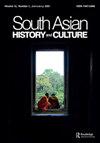Between trust and mistrust: master-servant relationships in Urdu writings of the 1860s–early 1900s
IF 0.3
0 ASIAN STUDIES
引用次数: 0
Abstract
ABSTRACT Based on texts dealing with life in North Indian Muslim households of the second half of the nineteenth century, covering genres such as didactic tales, letters, guidebooks, and an autobiographical narrative, this essay looks at the representation of master-servant relationships as presented in these texts from the perspective of the master/mistress. As this was a period of transformation when traditional aristocratic households were gradually replaced by the new middle class, this essay, through a close textual analysis, underscores the gap between the normative and actual behaviour of the employing class, underlining the changes that came about with respect to the service classes while it attempted to maintain or acquire respectability on reduced incomes.信任与不信任之间:19世纪60年代至20世纪初乌尔都语著作中的主仆关系
摘要本文以19世纪下半叶北印度穆斯林家庭生活的文本为基础,涵盖了说教故事、信件、指南和自传体叙事等类型,从主人/情妇的角度审视了这些文本中主人与仆人关系的表现。由于这是一个传统贵族家庭逐渐被新中产阶级取代的转型时期,本文通过仔细的文本分析,强调了雇佣阶级的规范行为与实际行为之间的差距,强调了当它试图在收入减少的情况下保持或获得体面时,服务阶级所发生的变化。
本文章由计算机程序翻译,如有差异,请以英文原文为准。
求助全文
约1分钟内获得全文
求助全文

 求助内容:
求助内容: 应助结果提醒方式:
应助结果提醒方式:


